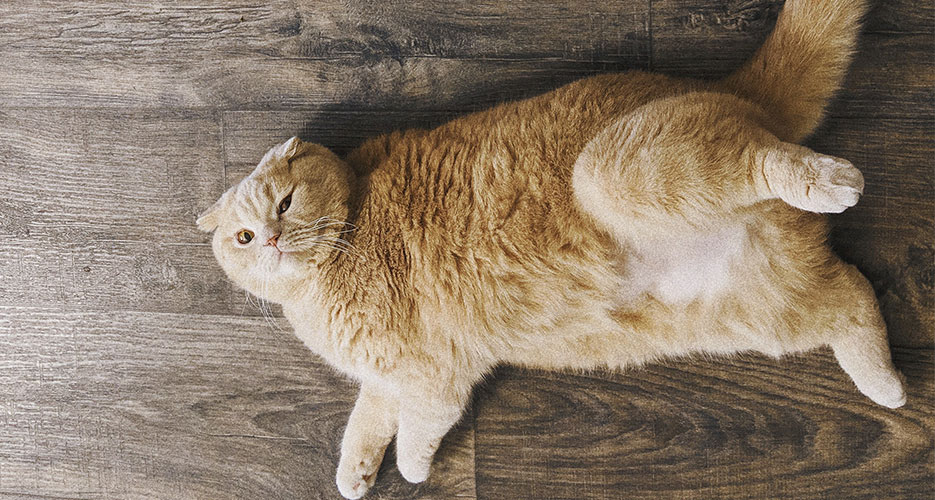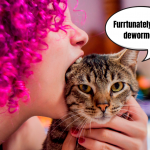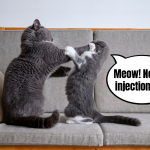Watching cat like Garfield may be funny, but fat furry in real life is already a serious problem. Extra kilograms at our pet could be a real threat to health and even life, not to mention the immediate financial failure of his caretaker.:) So how protect ourselves against the numerous problems resulting from cat obesity?
When the couch is like Mount Everest
When we’re seeing our cat every day, it’s easy to overlook the symptoms, that signal certain health anomalies. The extra weight of the furry is usually noticed aftewards. Often, the problem is noticed when the cat:
– has a problem with jumping on the couch
– doesn’t fit into its covered litter box or relieve itself outside it
– constantly drinks water
– licks up and scratches up to the wounds
Changing the silhouette of a cat and a significant increase in its weight can also be alarming (the animal being on the caretaker’s lap is clearly heavier), as well as the attention of a neighbour who will certainly not hesitate to tell us our cat has put on weight. 😉
Healthy cat means slim cat
Taking care of cat’s health is related to keeping him in good condition and not exposing to uncontrolled weight gain. Obesity and overweight are linked with many threats to health, including:
– joint overload and related further degenerative and inflammatory changes
– diabetes (more than 90% of obese cats suffer from diabetes. The cause of the disorder of blood glucose regulation is fat accumulated in the body)
– urinary tract diseases (obese cats move less and use the litter box less often, which causes urine in the bladder to cause health problems)
– skin problems (mainly due to the cat’s difficulties in caring for fur)
– cardiovascular and respiratory diseases (associated with hypertension due to obesity)
– colorectal diseases (tendency to constipation as a consequence of reduced motor activity)
– increased nervousness and susceptibility to stress (an obese cat has worse mobility and problems to hide)
As you can see there are many possible health implications associated with extra kilos and all of them lead to a reduction in the quality and life expectancy of the pet.
How to protect a cat?
We can bet, you can’t stop thinking about it! All difficulties in protecting a cat is… due to lack of resistance to sweetness of our furries. Cats asking for food all time, even when they’re full! Why is it happening? Well, as we know, cats are masters of manipulation of their human slaves and they know it’s worth. Sweet face, meowing, acting like starving (Do you know all these tricks?!) – everything what will be useful in a “emotional blackmail’s” operation. Anyway, there’s a moment, when we have to say “no”. The situation when we have to do it is when our lack of assertiveness can be danger to our cat and cause the obesity.In this case, one thing what we can do is quick swing into action.
Balanced diet
Just like in humans, in a cat’s life, a good diet is essential. If we want the cat to stay fit and weight correctly, we should follow the diet regime (all year round, not just like us, just before holidays :)). The content of the cat’s bowl will be important, as will the frequency of meals. Discipline will be just important as well. If the cat’s daily ration is well defined, pet can’t get anything extra from “under the table”. Of course, this is not about starving your cat. Weighting loss process should be slow and gradual, meals should be reduced, but not drastically, so as not to fund the animal with shock treatment and, at the same time, not threaten the life of a domestic canary. If you’re not sure how to reduce your cat’s daily food ration, help yourself by using the manufacturer’s hint on the food packaging (the portion will depend on the cat’s weight). It’s also worth using the experience and knowledge of a veterinarian specializing in cat nutrition.
Feeding is not allowed!
We know the plates with such an inscription from the ZOO, although they should also be found in more than one house. Secret feeding of a cat can ruin the actions of the most consistent cat caretaker, who aimed at losing weight his own pet. We know well how difficult it is to control it, e.g. when friends or family visited us at home and everyone wants to throw a tasty morsel to the furry to gain his favor and interest. It will be good to ask visitors not to do this, although we’re aware that such a request may not meet with satisfaction (both guest and cat).
Extra feeding, especially by people who are not a cat caretakers on a daily basis, may have, in addition to potential obesity, serious health consequences for the furry. Unfortunately, we have the impression that in society there’s a constant conviction that everything what human can eat can also be eaten by a domestic animal. It’s time to realize, there are absolutely prohibited products for the cat and it’s better to keep our furry from them away, otherwise it may end up with indigestion, diarrhea, and in the darkest scenario – pancreatitis. Let’s make people aware of it, so that the social gathering doesn’t end instead of at the table in the veterinary clinic.
Check what kind of food is forbidden for cats:
Acquired immunity for cat
We already know how not to feed the cat, but can we resist overfeeding our pet? Practice shows that there’s no such thing as a natural resistance to cat asking (who watched Shrek and recognize the big eyes of a Cat in boots certainly knows what we mean). Furries willingly take advantage of our weakness, and clever ones can even pretend to be hungry to achieve their goal (full bowl!). Therefore, be careful and exercise your immunity at every opportunity – believe us, it can be trained! We know what we’re saying – our boys have already grown up but when they were still cute kids, we had two young and eternally hungry furries under the roof and we practiced our assertiveness every day. King of asking of food was (and still is!) of course Teddy (his stomach was like a bottomless well and we have the impression that it stretched like rubber) and we didn’t have a respite from food request.
Optimum weight
Optimum cat’s weigh is an individual matter. However, it’s easier to determine what the silhouette of a properly feeding cat should look like. Let’s pay attention to the cat’s belly – if it’s indented in relation to the chest – everything is fine. After touching the ribs and the spine with a flat palm of the hand shouldn’t be felt bones, which in turn should be easily found by moving the place with your fingertips. A cat that has no problem with excess weight will also have clearly marked shoulders and hip bones, visible especially when moving (it will be better seen in individuals representing short-haired breeds). When the cat is struggling with overweight or obesity it will be completely the opposite – the abdomen will form a straight line with the chest, the ribs will be imperceptible, and the shoulders and hip bones practically invisible.
Cat’s silhouettes:
Is sterilization causes obesity?
Why does a sterilized cat get fat? Although this is not a rule for all furries, often the sterilization process actually affects the cat’s appetite. This is due to the hormonal economy, which after the procedure becomes disturbed (there is an increase in the concentration of luteinizing hormone, which is responsible for the increase in body fat). Especially shortly after the procedure (although this condition may persist for up to 15 weeks), we can observe increased cat’s appetite, so be prepared for situations in which calling for food will be much more frequent and the cat will look like hungry. However, you do not need to increase your daily food rations – despite the hormonal anomaly, your pet’s caloric demand stays the same, and increasing daily food intake can adversely affect on its weight.
Moves like a cat
A balanced cat’s diet is only half the battle. To keep your pet in good condition it will be important to provide him with adequate daily movement. This is especially important in the case of outgoing pets and those who stay alone at home for many hours and usually sleep through our absence.
Read also:
Playing is a great way to increase your cat’s physical activity. Let’s not forget to find some time for playing when we’re back from school or work – this may be the only chance for cat to burn some extra calories during the day. The simplest solutions always work – toys with herbs, fishing rod, jumping, chasing the ball or our ankles, games with obstacles. A great trick – especially when the cat doesn’t give us a break and constantly asks for treats – will be a maze or other puzzle game in which the prize is a snack. See what Justyna came up with from the myKotty team, using MIA’s cardboard for fun:
Like you can see, cats are like fabCats – diet and sport are crucial to keep yourself in a good shape (videos about furries work out yoga with their caretakers are one of the most popular on Instagram). Every form of playing or cat’s activity is a way for being fit.
Is there something what you want to add? Leave a comment?




